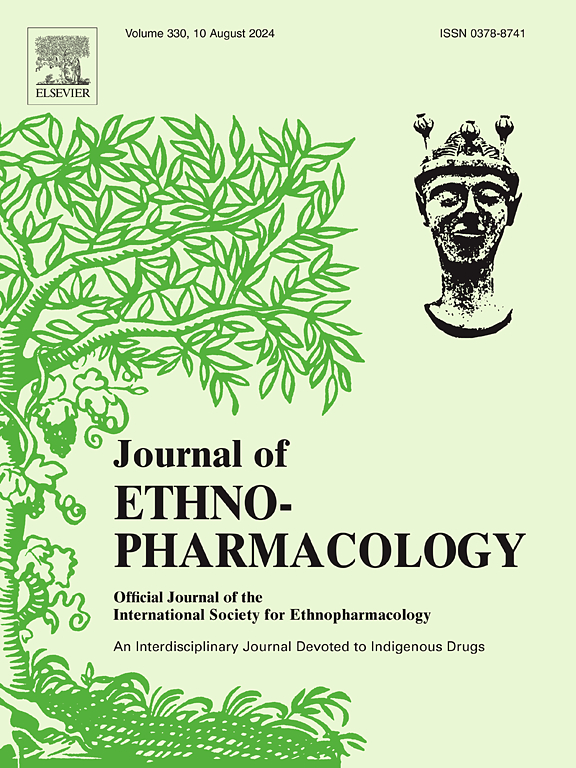Ethanol extracts of Cinnamomum migao H.W. Li attenuates neuroinflammation in cerebral ischemia-reperfusion injury via regulating TLR4-PI3K-Akt-NF-κB pathways
IF 4.8
2区 医学
Q1 CHEMISTRY, MEDICINAL
引用次数: 0
Abstract
Ethnopharmacological relevance
Cinnamomum migao H.W. Li, commonly known as migao (MG), is used in the Miao region of China for treating cardiovascular and cerebrovascular diseases, attributed to its detoxifying (Jiedu in Chinese), activating blood circulation (Huoxue in Chinese), and promoting Qi circulation (Tongqi in Chinese) properties. However, its therapeutic potential for ischemic stroke (IS) remains unexplored. Therefore, this study was to explore the protective effect of MG against cerebral ischemia-reperfusion injury caused by IS.
Aim of the study
The aim of this study was to investigate whether ethanol extract of MG (EEMG) attenuates cerebral ischemia-reperfusion injury, and explored the underlying mechanisms.
Materials and methods
Middle cerebral artery occlusion and reperfusion (MCAO/R) was established, and the efficacy of EEMG was evaluated using triphenyltetrazolium chloride (TTC), immunofluorescence, hematoxylin-eosin (HE) staining, and real-time quantitative PCR (qRT-PCR). Qualitative analysis of EEMG was analyzed for chemical composition by liquid chromatography-mass spectrometry (LC-MS). The molecular mechanism of EEMG was explored by metabolomics, network pharmacology, immunoblotting, immunofluorescence staining, gene knockdown, and agonist treatment.
Results
The results showed that EEMG alleviates ischemic injury in MCAO/R-operated rats and reduces neuronal damage of OGD/R-treated SH-SY5Y cells. Specifically, EEMG inhibited the release of inflammatory factors and reversed serum metabolic profile disorders of MCAO/R rats. Network pharmacology analysis showed that the PI3K-Akt and NF-κB signaling pathways play a role in the neuroprotective effects of EEMG against ischemic injury and in mitigating the inflammatory response. Consistent with our expectations, EEMG activated PI3K-AKT and suppressed NF-kB signaling pathways both in MCAO/R-operated rats and OGD/R-treated BV2 cells. The results showed that knockdown of TLR4 abolished the EEMG-mediated inhibition on neuroinflammation in OGD/R-treated BV2 cells. After treating BV2 cells with the TLR4 agonist neoseptin 3, EEMG showed a trend toward inhibiting neuroinflammation, though the effect was not statistically significant. Additionally, EEMG was found to improve liver injury caused by cerebral ischemia-reperfusion, which is associated with NF-κB signaling pathway in this study.
Conclusions
Collectively, this study demonstrated that EEMG attenuates neuroinflammation in cerebral ischemia-reperfusion injury via regulating TLR4-PI3K-Akt-NF-κB pathways.

肉桂乙醇提取物通过调节TLR4-PI3K-Akt-NF-κB通路减轻脑缺血再灌注损伤的神经炎症反应
民族药理学意义:肉桂(Cinnamomum migao H.W. Li),俗称 "米果"(MG),在中国苗族地区用于治疗心脑血管疾病,具有解毒(Jiedu)、活血(Huoxue)和益气(Tongqi)的功效。然而,MG 对缺血性中风(IS)的治疗潜力仍有待探索。因此,本研究旨在探讨 MG 对 IS 引起的脑缺血再灌注损伤的保护作用:本研究旨在探讨MG乙醇提取物(EEMG)是否能减轻脑缺血再灌注损伤,并探索其潜在机制:建立大脑中动脉闭塞再灌注(MCAO/R)模型,采用三苯基氯化四氮唑(TTC)、免疫荧光、苏木精-伊红染色(HE)和实时定量PCR(qRT-PCR)等方法评估EEMG的功效。液相色谱-质谱法(LC-MS)对 EEMG 的化学成分进行了定性分析。通过代谢组学、网络药理学、免疫印迹、免疫荧光染色、基因敲除和激动剂处理等方法探讨了EEMG的分子机制:结果表明,EEMG能减轻MCAO/R手术大鼠的缺血性损伤和OGD/R处理的SH-SY5Y细胞的神经元损伤。具体而言,EEHGT可抑制炎症因子的释放,并逆转MCAO/R大鼠的血清代谢紊乱。网络药理学分析表明,PI3K-Akt和NF-κB信号通路可能参与了EEMG介导的对缺血性损伤的神经保护作用和对炎症反应的抑制。正如我们所预期的,EEMG在MCAO/R-手术大鼠和OGD/R处理的BV2细胞中均能激活PI3K-AKT和抑制NF-kB信号通路。结果表明,TLR4的敲除抑制了EEMG介导的对OGD/R处理的BV2细胞神经炎症的抑制作用。在用 TLR4 激动剂新塞肽 3 处理 BV2 细胞后,EEMG 显示出抑制神经炎症的趋势,但差异不显著。此外,本研究还发现 EEMG 能改善脑缺血再灌注引起的、与 NF-κB 信号通路相关的肝损伤:总之,本研究表明,EEMG 可通过调节 TLR4-PI3K-Akt-NF-κB 通路减轻脑缺血再灌注损伤的神经炎症。
本文章由计算机程序翻译,如有差异,请以英文原文为准。
求助全文
约1分钟内获得全文
求助全文
来源期刊

Journal of ethnopharmacology
医学-全科医学与补充医学
CiteScore
10.30
自引率
5.60%
发文量
967
审稿时长
77 days
期刊介绍:
The Journal of Ethnopharmacology is dedicated to the exchange of information and understandings about people''s use of plants, fungi, animals, microorganisms and minerals and their biological and pharmacological effects based on the principles established through international conventions. Early people confronted with illness and disease, discovered a wealth of useful therapeutic agents in the plant and animal kingdoms. The empirical knowledge of these medicinal substances and their toxic potential was passed on by oral tradition and sometimes recorded in herbals and other texts on materia medica. Many valuable drugs of today (e.g., atropine, ephedrine, tubocurarine, digoxin, reserpine) came into use through the study of indigenous remedies. Chemists continue to use plant-derived drugs (e.g., morphine, taxol, physostigmine, quinidine, emetine) as prototypes in their attempts to develop more effective and less toxic medicinals.
 求助内容:
求助内容: 应助结果提醒方式:
应助结果提醒方式:


